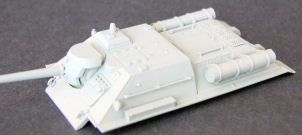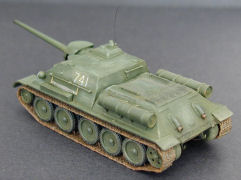
Unimodel 1/72 SU-85 Build Review
By Llarry Amrose
| Date of Review | March 2010 | Manufacturer | Unimodel |
|---|---|---|---|
| Subject | SU-85 | Scale | 1/72 |
| Kit Number | 333 | Primary Media | Styrene |
| Pros | Nice detailing | Cons | Vinyl road wheel tires |
| Skill Level | Basic | MSRP (USD) | $13.20 |
Background
The T-34 tank came as an unpleasant surprise to the Wehrmacht. It combined the protection of sloped armor with a fast and maneuverable suspension, and added a 76mm main gun that could handle anything the Germans had at that point. On top of that, the Soviets were able to commit the resources to produce incredible numbers of T-34s. Of course, technology never stays static, and soon Germany was fielding new and modified designs, intended to counter the capabilities of the T-34. Soviet designers continuously improved the T-34, including using the hull as a basis for other vehicles, including most notably, Tank Destroyers. Using a fixed mounting with extremely limited traverse allows for a simpler mounting, making it possible to carry a larger gun with a shorter design time and easier production.
The SU-85 introduced the powerful 85mm gun, which would later be turret-mounted (T-34/85), and 2644 were built, beginning in September 1943. About a year later, the SU-85M (also kitted by UM) entered service with an improved commander’s cupola and 30mm more front armor. Eventually a 100mm gun was mounted as the SU-100, which stayed in service around the world for many years.
The Kit
Inside the usual blue UM end-opening box are the usual green UM sprues. Sprue A (2 copies) contains the wheels, track links, grab bars, auxiliary tanks, and a few other usually symmetric doodads. B has the lower hull and sides. Together, these will look pretty familiar if you've seen any of the other UM T-34 or variant kits. Sprues D and E contain the upper hull and the other parts that distinguish the SU-85, the fenders, gun barrel and mantlet. Two copies of F contain all the vinyl tires for the road wheels and a couple of tow cables. Finally there is a small photoetched fret with three parts, only two of which get used -- the engine compartment grill cover and the ubiquitous two-man wood saw. The third part is only used for tanks with a hull machine gun mounted.
The standard 4-page instruction sheet includes a brief history in multiple languages and a parts layout with unused pieces shaded out. A small decal sheet completes the component list. As usual, there are a few extra decals not appearing in the provided marking schemes.
Assembly
Assembly begins with the lower hull, as well it should. With link-and-length tracks, it is generally easier to assemble them before adding the upper hull and fenders. In fact, it is quite possible to work on the upper and lower hulls simultaneously, which has the advantage of allowing work on one part to continue while the other waits for glue or paint to dry. In this case, I would recommend working on the front and rear halves of the upper hull separately, not bringing them together until it's time to join them to the lower hull, after the tracks are in place. This gives a little more flexibility in positioning.
The lower hull goes together simply, though you do need to be careful to get the nose and tail pieces right-side up. I like to have the major upper hull parts handy at this stage, using a little quick dry-fitting to make sure everything is properly squared up. Next come the road wheel axles and front idlers. I assemble the rear sprockets, but don't glue them on until I'm working on the tracks so I can make sure I get them lined up right. Paint comes next, while I can still get in, between, and behind everything. Then the vinyl tires are added to the road wheels, which are then mounted on the axles.
I've come to prefer link-and-length tracks, even in 1/72, and even though the newer "rubber-band" tracks from the likes of Dragon and Trumpeter have alleviated some of the old problems with attachment and paint adhesion. Still, link-and-length can be imposing until you've got a few sets under your belt. If you've never used them before, the UM T-34-hulled kits, like this one, just might be the best place to start. Take your time, do one side at a time, and pay close attention to the kit instructions, and you'll be surprised at how smoothly things go.
After painting the tracks, in a multilayer treatment of metal, rust, and blackwash, I start by positioning the long bottom run, but without glue. I then start to glue the next sections on each end, which bridge from the bottom up to the front idler and rear sprocket. Only once I have these lined up and attached do I go back and run a little glue to fix the bottom run in place. Starting with the bottom means that I will finish up on top, where any unevenness in the final connections can end up in track sag (though less so with the T-34 than others) and eventually hidden by the fenders and upper hull.
After the first couple of rear links are connected to the sprocket, I run a little liquid glue into the axle connection around back to fix the sprocket in place. Continuing around both ends with the individual links needed for the tighter curve, I finish up with the connection between the long top length and one of the shorter lengths next to it. A few minutes for the glue to set, and the other side quickly follows.
Meanwhile, the upper hull has gathered just about all of its structural and detail parts and a coat of paint. This way, the remaining paintwork once the upper and lower are united will be minimal, consisting mainly of touchup along the seams. Unusually for the kits in this line, there are actually optional parts to choose from. The A sprues contain both early and late handrails. The early ones are square, pipe-jointed bars, and the first paint scheme uses these. The later, one-piece bent metal rails are used for the other two schemes. The photoetched parts are worthy of note.
While the saw needs nothing but paint, the rear engine grille requires a partial curve. UM's brass is among the thickest I've ever seen, so, even if you normally don't bother, I have to recommend annealing the part. Heating the part in a candle flame -- get it to red-hot but without letting it burn up -- and then letting it cool will soften the part and make it possible to get a good curve of the rear half with a minimum of frustration.
Finally, the top meets the bottom, and all that remains is some seam and paint touch-up.
Painting
You can have your Soviet vehicle in any color you want, as long as it's green. Well, that's not exactly true, but it's the way to bet. There were some two-tone camouflages, and winter white schemes, but green predominates. There were specifications, but no matter how closely they were followed, variations will exist. Whether due to a bad batch, bad application, or just differences in wear and tear, two tanks sitting next to each may be different shades. Normally I use Vallejo's Russian Armor Green, but I like to introduce some variation, often simply by using different undercoats and keeping the green coat thinner.
The instructions include three vehicles. The first is from the 3rd Guards Tank Army on the Voronezh Front in autumn 1943. The markings consist simply of an identification number on each side. I chose this one since it used the early handrails, and since I knew I would also be building the SU-85M, which used the later style. The second scheme is from the 1047th SPG Regiment on the Baltic Front in the summer of 1944, and includes a slogan on one side and even red stars next to the identification numbers.
The third is from the 3rd Ukrainian Front in Romania also in the summer of 1944, and also uses just numbers on each side. The decals are some of UM's early type, which are very matte, fairly thin, but with fairly wide carrier film. Generally this isn't much of a problem if you have room to leave the entire carrier in place, as it tapers down well in thickness towards the edges and snuggles down to the surface pretty well. Lastly, Tamiya Weathering Master pastels were used to finish off the look.
Conclusions
All in all, an enjoyable and recommended build. The kit goes together quite well and appears quite accurate. Dimensionally it matches the specifications I have perfectly, and the shape matches the drawings and photos I have rather well, though I will admit that I am not an expert in Soviet armor.
I love UM kits. There, I've said it. While the moldings and engineering may not be quite up to state of the art, they are far better than what we usually call "short-run". They're pretty affordable, and cover subjects and variants that have rarely if ever been kitted in 1/72, and to a reasonable standard of accuracy. I particularly like the link-and-length tracks. As I said above, if you've never built l-n-l tracks in this scale, and are a little hesitant, a UM T-34-hulled kit is probably the best place to start.
I’ve now built all three of the SU-85/100 series. Most builders won’t need all three, but any one makes a nice addition to a collection, and a fun build.
My sincere thanks to Squadron Mail Order for this review sample!
References
- Wikipedia.com
- Absolute Air Land & Sea CD-Rom (Cassell / Tamiya)
- Various books off the book shelves
















